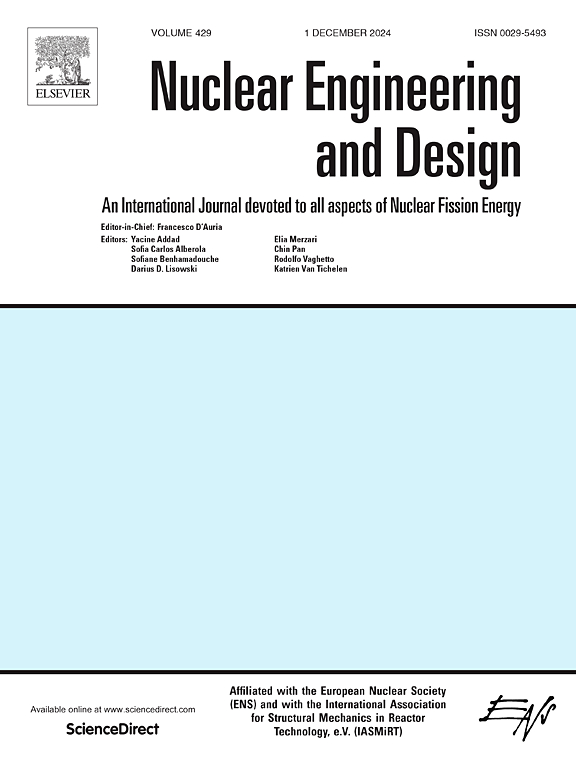Application of genetic algorithms to optimize fuel loading pattern and use of burnable absorbers to minimize power peaking and control excess reactivity in gas cooled fast reactor
IF 1.9
3区 工程技术
Q1 NUCLEAR SCIENCE & TECHNOLOGY
引用次数: 0
Abstract
This study aims to optimize the fuel loading pattern in gas-cooled fast reactors (GFRs) using genetic algorithms (GA) to reduce the power peaking factor, and in the GA-optimized model, several burnable absorbers (BA), namely Gd2O3, Er2O3, AmO2, ZrB2, HfO2, Ta2O5, Dy2O3, Eu2O3, and Lu2O3 were deployed to control excess reactivity and further enhance power distribution. The GA-optimized fuel loading pattern significantly lowered the power peaking factor without compromising the effective multiplication factor. All GA + BA models, except for the Am and ZrB2 models, successfully minimized both power peaking and excess reactivity. The Eu and Lu models demonstrated best result in reducing these parameters, though the Eu model’s shorter cycle length and larger reactivity swing make it less favorable. Gd, Er, Hf, Ta, and Dy models also displayed satisfactory performance in lowering both PPF and excess reactivity, and maintained criticality for over 2000 days with moderate reactivity swings. Neutronics analysis revealed that all models achieved harder neutron spectra and maintained uniform radial neutron flux distribution. Additionally, all models achieved satisfactory values for the effective delayed neutron fraction and fuel temperature coefficient, except Ta and Eu model. Overall, the Lu model emerged as the most favorable burnable absorber, as it achieved lower power peaking factor, reduced excess reactivity, good cycle length, moderate reactivity swing, satisfactory neutronics performance, and favorable beta effective and Doppler constant values.
求助全文
约1分钟内获得全文
求助全文
来源期刊

Nuclear Engineering and Design
工程技术-核科学技术
CiteScore
3.40
自引率
11.80%
发文量
377
审稿时长
5 months
期刊介绍:
Nuclear Engineering and Design covers the wide range of disciplines involved in the engineering, design, safety and construction of nuclear fission reactors. The Editors welcome papers both on applied and innovative aspects and developments in nuclear science and technology.
Fundamentals of Reactor Design include:
• Thermal-Hydraulics and Core Physics
• Safety Analysis, Risk Assessment (PSA)
• Structural and Mechanical Engineering
• Materials Science
• Fuel Behavior and Design
• Structural Plant Design
• Engineering of Reactor Components
• Experiments
Aspects beyond fundamentals of Reactor Design covered:
• Accident Mitigation Measures
• Reactor Control Systems
• Licensing Issues
• Safeguard Engineering
• Economy of Plants
• Reprocessing / Waste Disposal
• Applications of Nuclear Energy
• Maintenance
• Decommissioning
Papers on new reactor ideas and developments (Generation IV reactors) such as inherently safe modular HTRs, High Performance LWRs/HWRs and LMFBs/GFR will be considered; Actinide Burners, Accelerator Driven Systems, Energy Amplifiers and other special designs of power and research reactors and their applications are also encouraged.
 求助内容:
求助内容: 应助结果提醒方式:
应助结果提醒方式:


